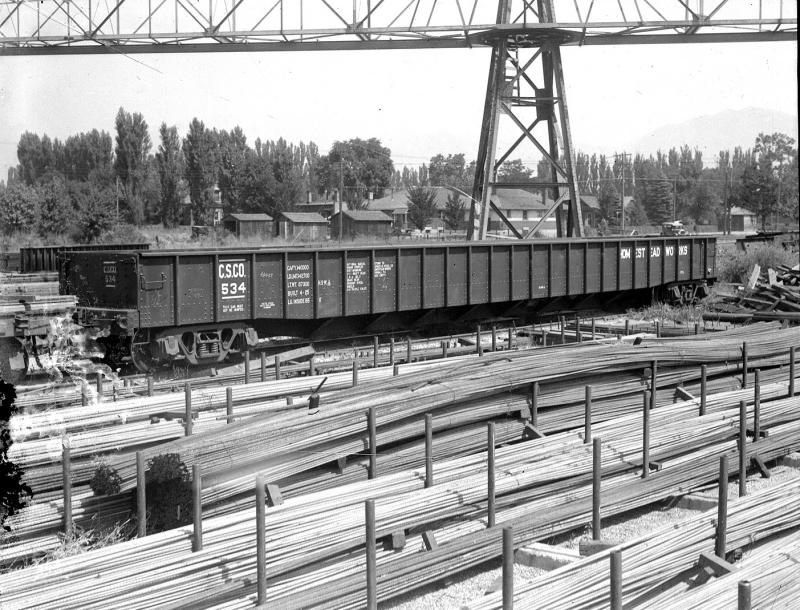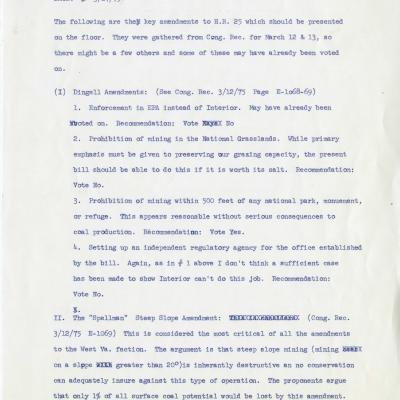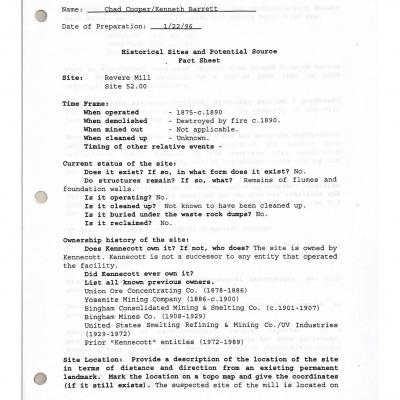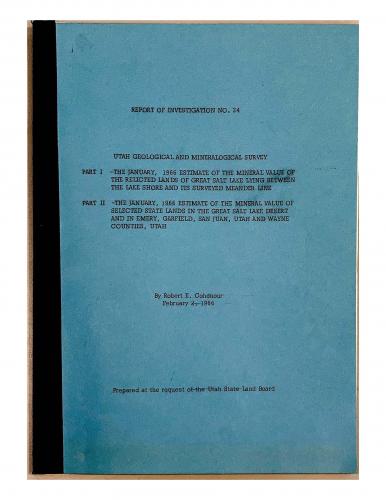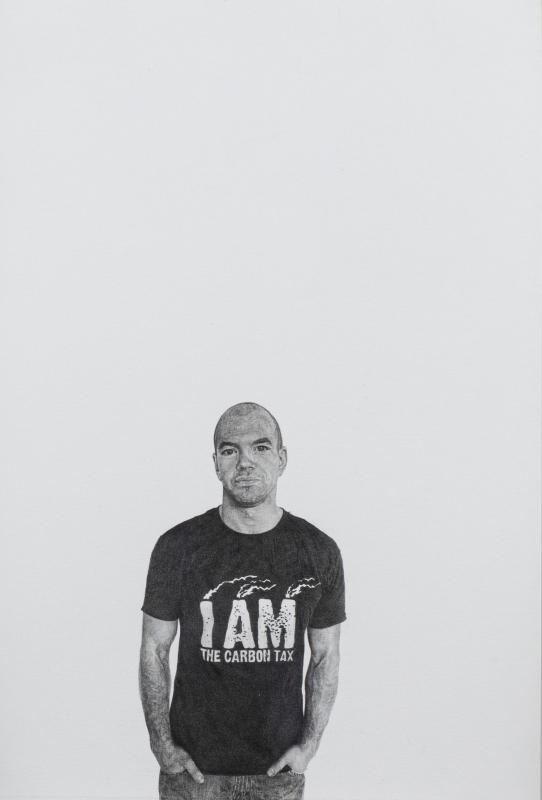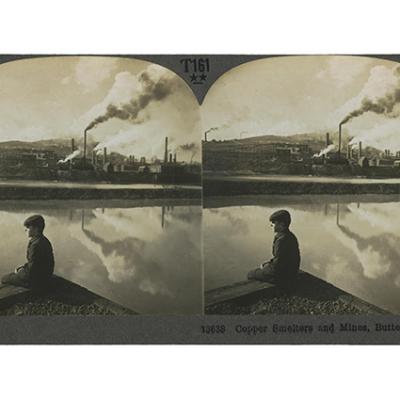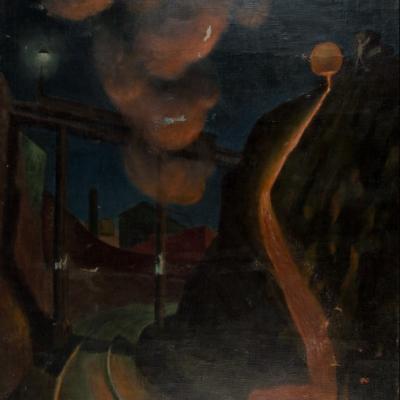Industry Economic Human Landscape
Environmental Legacies
In Special Collections
At the Utah Museum of Fine Arts
Related Resources
During the nineteenth and early twentieth centuries, lumber was consumed voraciously to fuel smelters, build mine supports and railroad tracks, and supply construction materials for growing towns. The Roy P. Full papers reveal the lumber consumption during this time period. Full, a geologist, served as an expert witness in Indian Land Claims cases. The Indian Claims Commission, established in 1946, created a process through which Native American tribes could pursue cases against the U.S. government for territory taken in violation of federal treaties. The tribes were awarded monetary compensation in lieu of land lost. Expert witnesses like Full assessed the amount and value of land and resources seized, including lumber and minerals that lay therein.
Concerns about environmental degradation and its effects on human health grew in the twenty-first century. Representative Allan Howe (D-Utah, 1975-1977) served on the Interior and Insular Affairs committee at a midpoint in the “environmental decade." His political papers include clear, accessible policy briefs written by Howe’s staffers regarding the creation of the Surface Mining Control and Reclamation Act (SMCRA).
Prior to the passage of SMCRA, coal mines could be abandoned after resources were tapped or the ore was determined to be of low grade. SMCRA requires coal mine operators to plan for land reclamation following the closure of a mine; taxes imposed on each ton of coal extracted fund reclamation activities. Despite increased regulation post-1977, former mining sites continue to affect the American West landscape and its peoples. Utah has an estimated 16,000 abandoned mines and mill tailings sites, 500 of which are located on the Navajo Nation. In the 1990s, Kennecott Copper narrowly escaped being listed on the Superfund National Priorities by agreeing to clean up several zones that leached toxic chemicals into air, water, and land resources.
Although Rep. Howe supported the SMCRA, he also supported the 1975 Federal Coal Leasing Amendments Act, created to "stimulate the timely development and production of coal from federal leases."
Mineral resources continue to be a primary source of funding for many Utah state agencies. Royalties from energy development leases (leases to private companies to drill on state and federal land) comprise the greatest source of income for the Utah public school system, as well as financing the Utah Department of Transportation and the Utah Geological Survey.
The papers of United States Senator Frank Moss, (D-Utah, 1959-1977) document the struggle for control over the mineral (including sodium, potassium, magnesium, and more), oil, and gas resources (and accompanying lease royalties) of the Great Salt Lake between the State of Utah and the federal government. Senator Moss was well-known for his support of environmental legislation, including his co-sponsorship of the Clean Air Act and other enactments that expanded national parks. However, Senator Moss counterbalanced this work with the economic concerns of the state. When the federal government asserted control over the lakebed of the Great Salt Lake, Senator Moss, cognizant of the financial implications of this move, successfully drove the effort to designate the title of the lakebed to the State of Utah. The majority of the lake is still open for new leases for salt, oil, and gas leasing (see maps 5.1 and 5.2 of the Final Great Salt Lake Mineral Leasing Plan and Record of Decision, March 2013).
Andrea Bowers, Tim DeChristopher (I Am the Carbon Tax), 2010. UMFA2010.17.1.
Andrea Bowers, The United States vs. Tim DeChristopher, 2010. UMFA2010.17.2.
Los Angeles-based Andrea Bowers’ (b. 1965) portrait and film of Tim DeChristopher exemplifies the artist’s commitment to investigating the sociopolitical issues of climate change and social protest.
At the end of 2008, Tim DeChristopher, then enrolled as an economics student at the University of Utah, achieved notoriety by derailing a Bureau of Land Management (BLM) auction of oil and gas leases on southern Utah’s public lands. Environmentalists gathered outside the Salt Lake City building where the auction was being held, protesting the BLM’s “gift” to energy interests. DeChristopher took his protest a step further, taking a seat amongst the hopeful collectors after registering himself as “Bidder 70.” DeChristopher intentionally drove the parcel prices to extravagant heights that day by outbidding all of the auction offers, but chaos ensued when it became clear that the university student had no intent to use the 22,500 acres in question nor the $1.8 million necessary to fund his winning bids. The auction was brought to a halt as federal agents took DeChristopher into custody under fraud charges. A subsequent review proved to courts that most of the BLM’s lease offers at the auction were illegal. Nevertheless, DeChristopher was convicted and served 21 months in prison.
Utah Abandoned Mine Reclamation documents how the State of Utah reclaims abandoned mines that are physically dangerous to visitors or that present an environmental hazard. (Seth Button)
Health and Environmental Impacts of Mining outlines lasting effects of mining on the earth. (Daniel Mendoza)
Deeply Dependent, a print inspired by the Bingham Mine, is a physical exploration of materials and processes and a conceptual investigation of the materials we" remove to sustain our technologically advanced practices and ways of living." (Marnie Powers-Torrey)
An Interview with Tommy Rock An interview about environmental justice with Dr. Tommy Rock, a member of the Navajo Nation, who has conducted research on water quality along the Puerco River, downstream from uranium mill and mining sites. (Tommy Rock)
Pink Moon Atlas uses pigments gathered from industrial mining sites in letterpress prints and handbound books that are "emergent with observations from experience, divergent technologies, and multiplicities generated by Ochre on the page." (Elpitha Tsoutsounakis)
Connecting the Dots for a Just Transition post-uranium extraction on Diné Land with App-activated, storytelling-based portraiture that emboldens restorative economics and memory making "advocate[s] for a reformed approach to environmental remediation underway on Navajo Nation, with the aim of training Diné hydrologists, scientists, documentarians, and artists in remediation and activism instead of allowing former polluters to financially benefit from this work." (Will Wilson)
Research and the Artivist
Lesson Plan, 8th - 12th Grades, Adaptable for Younger Audiences
Sydney Porter Williams
A lesson plan where students research Salt Lake City’s Inland Port, a relevant Utah issue. Students will evaluate the port as a design solution, choose a stance on whether or not they support the port, and create protest signs to back their decision.
The Big Idea Generator: Improve the Future
Lesson Plan, 4th Grade, Adaptable for Other Levels
Sheree Freeze Birrell
A collaborative mixed media collage using expressive, colors, textures, and mark making that generates ideas to improve how we manage our land and natural resources in the future.
Reclaimed Art, Reclaimed Land
Lesson Plan, 3rd Grade
Kimberly Andrade
This lesson focuses on the problems that come with mining the west and how there are potential ways to stop these problems maintaining everyday needs with more sustainable solutions. 3rd graders will learn about mining and reclaimed land, create a collage, and then will look at different ways to conserve Earth's environment. The lesson will culminate with a painting that reflects reclaimed lands over their collages.

